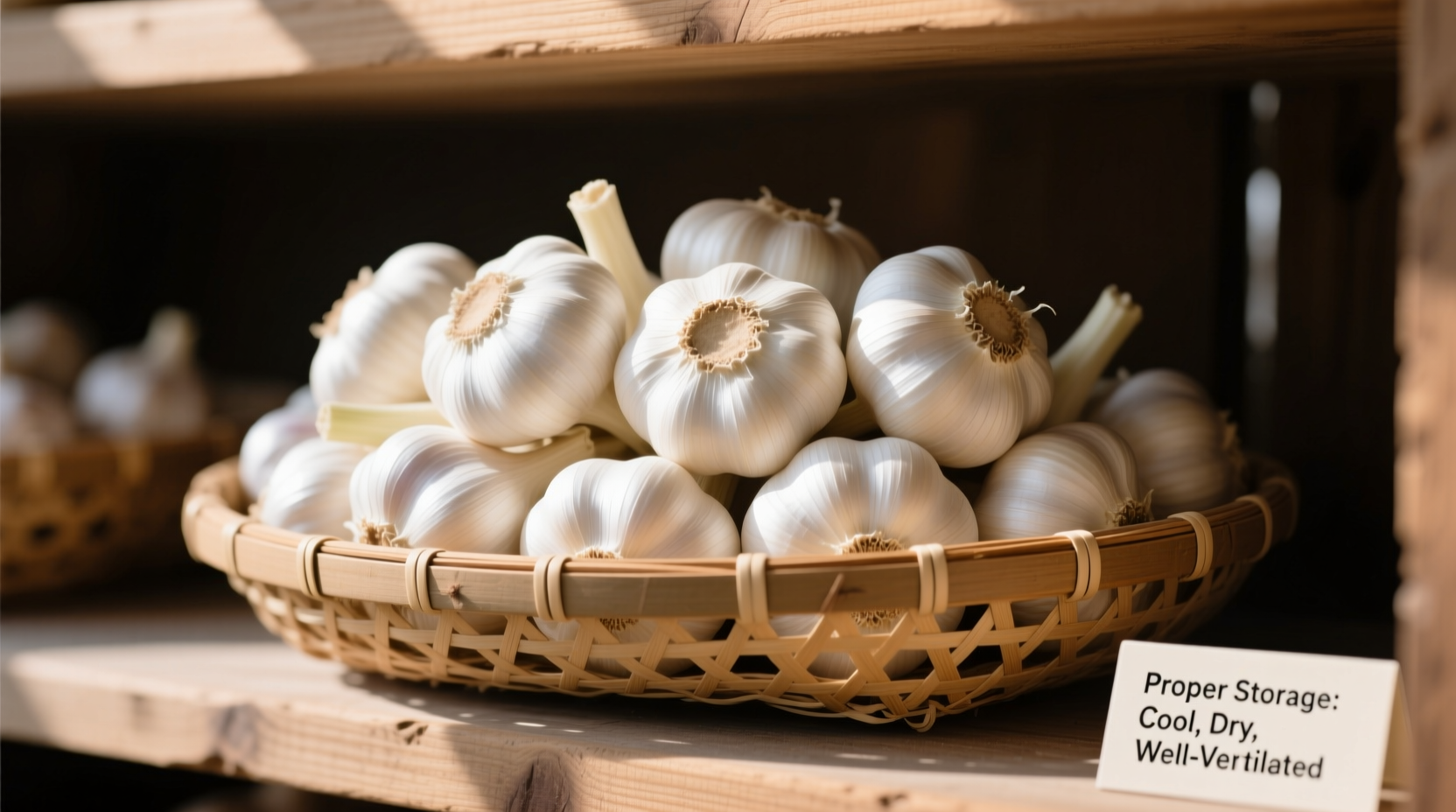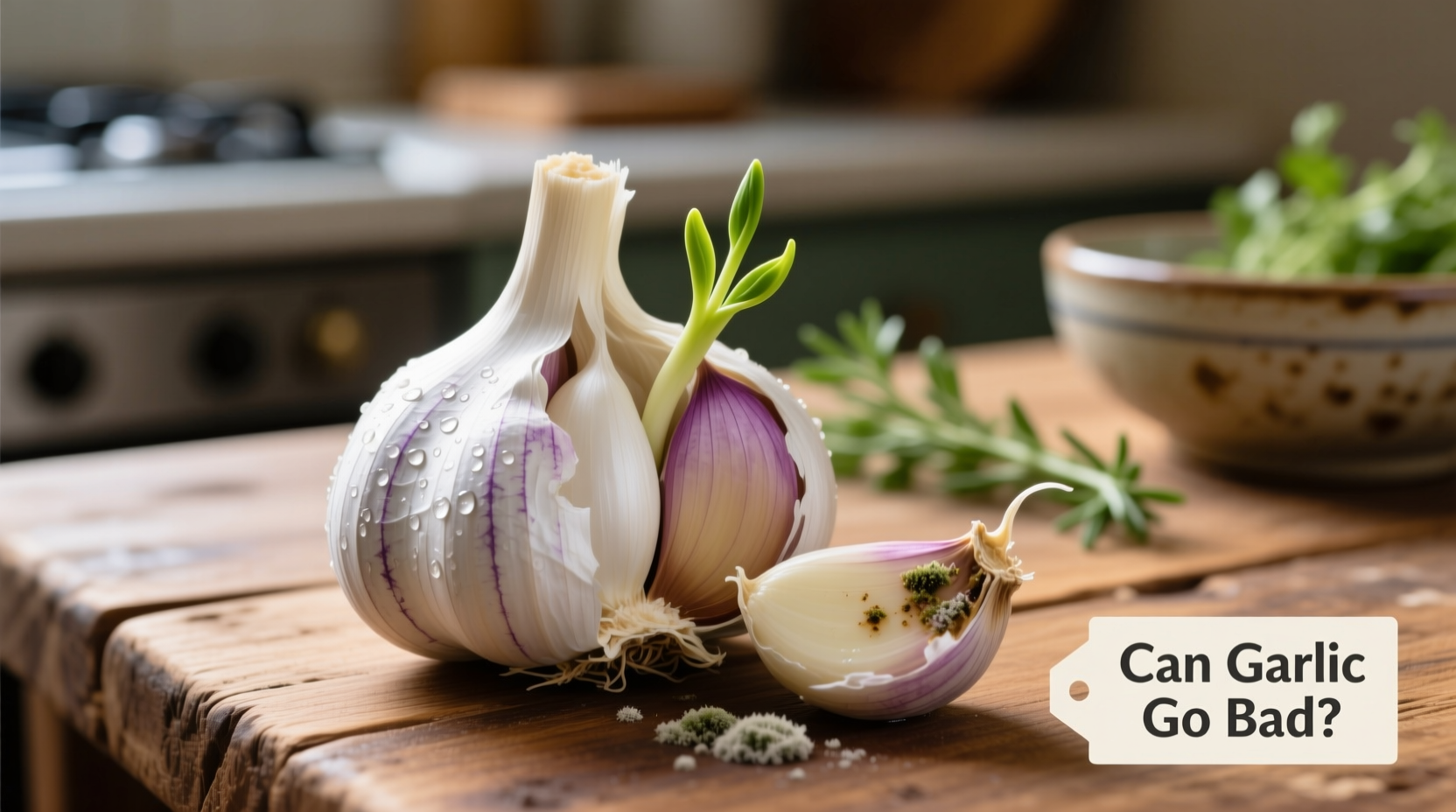Yes, garlic absolutely can go bad. Fresh garlic typically lasts 3-6 months when stored properly, but signs of spoilage include soft spots, brown patches, mold growth, and a sour or unpleasant odor. Consuming spoiled garlic can cause foodborne illness, so proper storage and regular inspection are essential for food safety.
How to Identify Spoiled Garlic: Your Visual Inspection Guide
Garlic doesn't suddenly turn bad—it shows clear warning signs as it deteriorates. Knowing what to look for helps prevent food waste while keeping your kitchen safe.
Physical Indicators of Bad Garlic
Examine each clove carefully before use. Fresh garlic should feel firm and heavy for its size. Watch for these red flags:
- Texture changes: Soft or mushy spots indicate internal decay
- Color abnormalities: Brown or yellow spots spreading across cloves
- Mold presence: Fuzzy white, green, or black growth on surface
- Root development: Excessive sprouting with green shoots longer than 2 inches
- Odor issues: Sour, unpleasant smell instead of characteristic pungency
| Condition | Safe to Use? | Recommended Action |
|---|---|---|
| Firm cloves with tight skin | Yes | Store properly for future use |
| Minor brown spots on outer skin | Yes | Peel and use immediately |
| Soft spots or significant discoloration | No | Discard entire clove |
| Visible mold growth | No | Discard entire head (mold spreads internally) |
| Green sprout in center | Yes | Remove sprout and use clove |
Garlic Shelf Life Timeline: Maximizing Freshness
Understanding how long garlic lasts under different conditions helps prevent premature spoilage. The USDA Food Safety and Inspection Service confirms that proper storage significantly extends garlic's usability.
Storage Methods Compared
Based on research from the University of California Agriculture and Natural Resources, here's how different storage approaches affect garlic longevity:
| Storage Method | Expected Shelf Life | Best For |
|---|---|---|
| Cool, dark pantry (60-65°F/15-18°C) | 3-6 months | Whole bulbs |
| Mesh bag with airflow | 2-3 months | Individual cloves |
| Refrigerator (in crisper drawer) | 7-10 days | Peeled cloves only |
| Freezer (in oil or dry) | 10-12 months | Prepared garlic |
| Countertop in direct sunlight | 2-3 weeks | Avoid this method |

Professional Storage Techniques That Work
As a chef who's worked with garlic in professional kitchens for over 15 years, I've learned that proper storage makes all the difference. Here are the methods that actually work:
The Ideal Storage Environment
Garlic thrives in conditions that mimic its natural growing environment. According to FoodSafety.gov, the optimal storage conditions include:
- Temperature: 60-65°F (15-18°C) - cooler than room temperature but warmer than refrigeration
- Humidity: 60-70% - enough moisture to prevent drying but not so much that mold develops
- Airflow: Essential for preventing moisture buildup that leads to spoilage
- Darkness: Light triggers sprouting and accelerates deterioration
Storage Solutions That Actually Work
Forget the refrigerator myth—professional kitchens use these proven methods:
- Braiding technique: Hanging garlic in braids maintains airflow and extends freshness
- Mesh or wire baskets: Allow 360-degree air circulation around bulbs
- Clay garlic keepers: Regulate humidity while providing darkness
- Wicker baskets: Traditional method that works exceptionally well
What NOT to Do With Your Garlic
Avoid these common mistakes that accelerate spoilage:
- Storing in plastic bags (traps moisture)
- Keeping in the refrigerator (promotes sprouting)
- Storing near heat sources like stoves or ovens
- Washing before storage (adds excess moisture)
- Storing with potatoes (they emit moisture and gases that speed decay)
When Sprouting Happens: Salvaging Aging Garlic
Seeing green sprouts emerging from your garlic cloves? Don't panic—this doesn't automatically mean your garlic has gone bad. The sprout itself is edible but has a bitter taste that can affect your dish.
Here's what to do:
- Cut the clove in half lengthwise
- Remove the green sprout from the center
- Use the remaining garlic immediately (don't store after sprout removal)
- Consider using sprouted garlic in cooked dishes where bitterness is less noticeable
According to research published by the National Center for Home Food Preservation, sprouted garlic maintains most of its beneficial compounds, though the flavor profile changes significantly.
Food Safety Considerations: When Garlic Becomes Dangerous
While most spoiled garlic simply loses quality, certain conditions create serious health risks. The FDA warns that improperly stored garlic in oil can lead to botulism poisoning—a potentially fatal condition.
Botulism Risk: The Hidden Danger
Garlic stored in oil at room temperature creates the perfect anaerobic environment for Clostridium botulinum bacteria to grow. This is particularly dangerous because:
- There are no visible signs of contamination
- No unusual odor develops
- Even a small amount can cause severe illness
If you prepare garlic-infused oil, always:
- Refrigerate immediately
- Use within 7 days
- Never store at room temperature
- Consider adding acid (like lemon juice) to inhibit bacterial growth
Practical Tips for Maximizing Garlic's Shelf Life
Implement these professional techniques to get the most from your garlic harvest or grocery purchase:
Selection Matters: Choosing Long-Lasting Garlic
Start with quality bulbs that will naturally last longer:
- Choose firm bulbs with tight, papery skin
- Avoid bulbs with visible sprouting or soft spots
- Select larger bulbs for longer storage (smaller ones deteriorate faster)
- Hardneck varieties typically store 3-5 months; softneck varieties last 6-9 months
Preservation Methods for Extended Use
When you have more garlic than you can use fresh, try these preservation techniques:
- Freezing: Peel cloves and freeze in airtight containers (up to 12 months)
- Drying: Dehydrate slices for use in spice blends (6-12 months)
- Pickling: Preserves flavor while adding culinary versatility (6 months refrigerated)
- Garlic paste: Mix with oil and freeze in ice cube trays for portioned use
Frequently Asked Questions
Can you eat garlic that has sprouted?
Yes, sprouted garlic is safe to eat. Simply remove the green sprout from the center of the clove, as it can be bitter. The remaining garlic is perfectly safe and retains most of its nutritional value, though the flavor profile changes slightly.
How long does garlic last in the refrigerator?
Whole garlic bulbs should not be refrigerated as cold temperatures promote sprouting. However, peeled individual cloves can last 7-10 days in the refrigerator when stored in an airtight container. Minced or chopped garlic lasts only 5-7 days refrigerated.
What causes garlic to turn green or blue?
This natural color change occurs when garlic's sulfur compounds react with acids or metals during cooking. It's completely safe to eat and commonly seen in pickled garlic or when cooking with cast iron. The flavor remains unaffected, though the appearance changes.
Can you freeze fresh garlic?
Yes, freezing is one of the best preservation methods. Freeze whole unpeeled cloves in airtight bags for up to 12 months. For convenience, peel cloves first and freeze in oil using ice cube trays for portioned cooking use. Frozen garlic doesn't spoil but may lose some texture.
Is it safe to store garlic in oil at room temperature?
No, storing garlic in oil at room temperature creates a serious botulism risk. The FDA strongly advises against this practice. If making garlic-infused oil, always refrigerate immediately and use within 7 days. Commercial products use acidification and special processing to make shelf-stable garlic oil.











 浙公网安备
33010002000092号
浙公网安备
33010002000092号 浙B2-20120091-4
浙B2-20120091-4